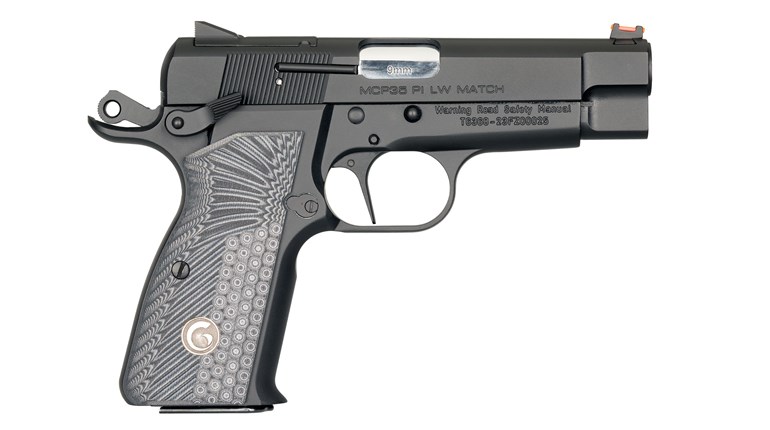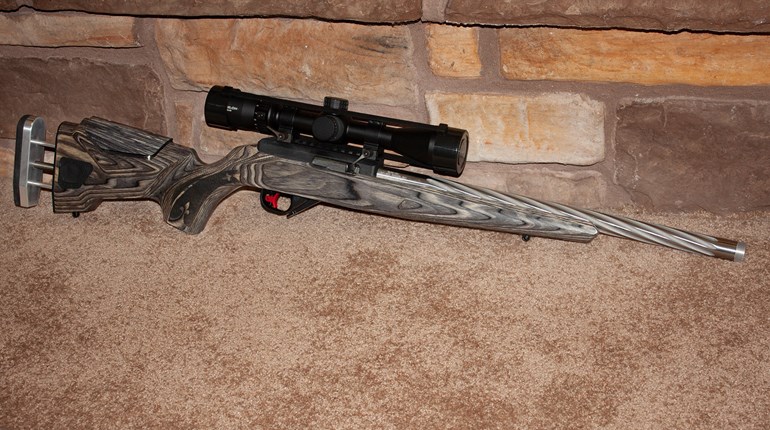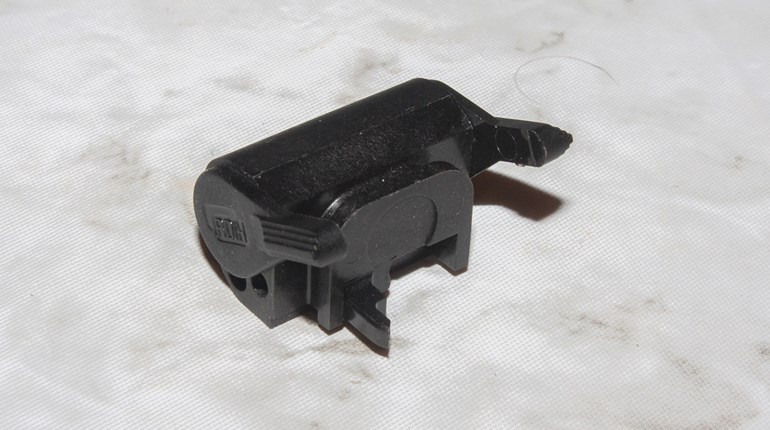
Given the array of handguns available on today’s commercial market, made from materials ranging from steel to lightweight alloys and polymer, most consumers would be hard-pressed not to find a personal-protection pistol to suit their preferences and, of course, their budget. But, what if the person doesn’t possess sufficient manual dexterity to load a revolver’s cylinder or cock its hammer and/or the necessary strength to seat a semi-auto’s magazine or rack the slide?
When the question pertains to selecting a handgun for someone with a physical disability, the answer is not simply a matter of determining what they want or even what they can afford. Rather, the decision must also be weighed within the limitations of one’s disability.

The Need is in the Numbers
The year 2011 marked a rapid growth of the people from the baby-boom generation turning 65. By 2020, baby-boomers will be pre- and/or early-retirement ages.1 In 2014, 1,062,730 individuals ages 18 and over “living in the community” [i.e. who are not living in institutions such as jails, prisons, nursing homes, hospitals, etc.] reported having a military service-connected disability rating of 70 percent or more. That same year, there were 9,750,976 civilian veterans ages 18 to 64 years “living in the community,” 1,170,385 of which were individuals with disabilities.2 Furthermore, a summary on the annual number of violent victimizations categorized by victim disability status cites, “The rate of violent victimization for persons with disabilities (36 per 1,000) was more than twice the age-adjusted rate for persons without disabilities (14 per 1,000) in 2013... Persons with disabilities experienced about 1.3 million violent victimizations in 2013. Rates of serious violent victimization—rape, sexual assault, robbery, or aggravated assault—were more than three times higher for persons with disabilities (14 per 1,000) than the age-adjusted rate for persons without disabilities (4 per 1,000).”3
Let’s face it, given the aging baby-boomer population, the rising number of veterans returning home with some form of disability and that persons with disabilities are at more than three times greater risk of being targeted by violent criminals, a firearm designed to accommodate the needs of the elderly and/or the disabled has been long overdue. Fortunately, the wait is over.
1. National Institute of Aging/U.S. Department of Commerce Economics and Statistics Administration, “Aging in the United States: Past, Present, and Future”
2. U.S. Census Bureau, “American Community Survey,” “Annual Disability Statistics Compendium”
3. National Crime Victimization Survey, U.S. Census Bureau, “American Community Survey”

A Change in Form and Function
Enter Matthew Carmel, owner of Constitution Arms, who recognized the shortcomings of traditional-firearm designs for those with disabilities and has worked tirelessly for more than a decade to bring his alternative design to the commercial market. Named the Palm Pistol, it is marketed toward the elderly, the disabled and those with limited strength or dexterity.

In 2005, Carmel founded Constitution Arms. As an NRA-certified firearms instructor in New Jersey, Carmel observed how many of his students with little shooting experience typically were unable to keep their muzzle movement to a minimum, which resulted in poor accuracy. He also noticed how beginners had a tendency to shake from anticipation of the gun going off, fear of felt recoil and apprehension of gun-handling in general. When asked about the inspiration for his design, he replied, “I was sitting in my workshop one day, playing around with a T-handled screwdriver. And I was thinking about the recurring problem I have with the seniors I teach, loading cartridges, locking slides and hand weakness… I was thinking minimalist. If I start with just a cartridge, what is the minimal thing I have to put around it in order to ignite the primer and send this projectile downrange?”
The T-handled screwdriver in Carmel’s hand suggested the answer. The minimal “thing” needed was a barrel, a breech, and a short butt or handle. The pistol would fit the palm, and sport a design that is ambidextrous and bilaterally symmetrical, making it easy for the pistol to be fired effectively without regard to hand or eye dominance. But bringing his concept to fruition was far from easy. After creating sketches and consulting with friends knowledgeable about firearms, the one common concern was the suspicion his creation might be considered an Any Other Weapon (AOW) as defined by the National Firearms Act. Such a designation would mean additional red tape and bureaucratic hurdles—not to mention an extra tax on the firearm—all of which would make bringing the Palm Pistol to market much more difficult. Carmel consulted Stephen Halbrook, an attorney who specializes in firearms law, and after 18 months the Bureau of Alcohol, Tobacco, Firearms and Explosives informed Carmel the Palm Pistol qualified as a traditional pistol. Be that as it may, closer examination of the Palm Pistol reveals it to be anything but standard.
One-of-a Kind Design
Unlike most defensive handguns on the market, the Palm Pistol was designed to be a single-shot breechloader, one of Carmel’s many ways of marketing his creation to a select clientele. Its simplified manual-of-arms would be easier for those who, according to the company website, “…wish to participate in and enjoy recreational target shooting but heretofore could not due to medical conditions affecting manual dexterity and/or hand strength, including grip limitations. It is also suitable for personal self defense…” The same can’t be said for traditional revolvers or semi-automatics, which explains why people with disabilities need something different. But that’s not all separating this novel pistol from other handguns.

In addition to its ergonomic, palm-shaped grip, perhaps the greatest departure from run-of-the mill firearms is the use of the thumb to release the firing pin/striker. One of the two principal factors of inaccurate fire is lateral muzzle drift, which is typically induced when the trigger is pulled with the index finger. Use of the thumb for releasing the firing pin mitigates this problem. More importantly, since the thumb is stronger than the index finger, the incorporation of thumb-based firing enables use by those with a wide range of disabilities, such as phalangeal amputations, arthritis, fusions and other conditions involving manual-dexterity limitations, including mine: cerebral palsy.
Dual trigger buttons, located on the distal ends of the oval-shaped stock, promote ambidextrous use, along with up to 14 different ways to grip and fire the pistol. So, regardless of whether the barrel is held between your middle and ring fingers, index and middle fingers or ring finger and pinky, unlike traditional firearms the Palm Pistol permits the freedom of a modified grip to suit a shooter’s individual needs. The addition of zero-bore axis directs recoil forces rearward into the palm and along the center of one’s forearm, mitigating muzzle flip. That, in conjunction with its mild .38 Spl. chambering, should add a degree of comfort when sending lead downrange. Ergonomics are further addressed in the form of two interchangeable (large/small) backstraps, enabling the handgun to be sized to fit an individual’s hand.

What the Palm Pistol lacks in size, it makes up with 10 safety-oriented features, including three independent safeties that must be activated by the shooter, using a minimum of three different fingers before the pistol can be fired. Each trigger, in the form of a button, is concealed beneath its own spring-loaded cover to prevent unintentional actuation. The barrel is flanked by a pair of grip safeties, both of which must be fully depressed before either trigger will operate.

The Palm Pistol also sports common safety features, such as a loaded-chamber indicator, a cocked-striker indicator and a hand-stop to keep your fingers safely behind the barrel’s threaded muzzle. Those 5⁄8x24 threads can accommodate optional accessories, like a barrel extension to provide greater leverage to open/close the action. Since the pistol lacks conventional sights, aiming is best accomplished by installing a laser sight on the optional Picatinny rail, which attaches to the handguard via a hex-head screw.
Much like the Palm Pistol’s aesthetics, its manual-of-arms is equally unconventional. Firing the Palm Pistol involves gripping the stock in your dominant hand with barrel held between the index/middle, middle/ring, or ring/little fingers and the grip firmly against the palm of the hand. Fully depress the two grip safeties located on either side of the barrel, with the palm side of the fingers being used to grip the stock. Both grip safeties must be fully and independently depressed before the gun can be fired. Next, push the trigger cover closest to your thumb up and forward with your thumb and place your thumb on the trigger button.

Installing the large backstrap and grasping the barrel between the middle and ring fingers provided sufficient access for my fingers/thumb to reach both grips safeties and trigger buttons. Given the uniqueness of the Palm Pistol’s design—and the variety of ways in which it can be held—there was a bit of a learning curve when it was time to go to the range. The biggest hurdle was attempting to gain enough leverage to close the action while depressing the grip safeties, which I accomplished by using the index fingers of both hands to actuate both grip safeties as I placed the side of the muzzle against my scooter’s steering wheel while closing the action.

Shooting the Palm Pistol proved quite pleasant. Recoil from the.38 Spl. went straight back in my hand. Low pressure generated by the mild chambering made for minimal muzzle movement and kept case extraction relatively easy—though more spring tension on the ejector rod would have made an easier job of plucking brass from the chamber. Interestingly, the Palm Pistol can be fired by pressing one trigger button or both. The latter distributes the weight evenly between each button, cutting the pull (or in this case, press) weight to a more-manageable 4.3 pounds. Finger placement on each button proved tricky at first, especially with having to move the spring-loaded caps out of the way prior. The solution was to stage my grip by having my thumb and pinky in place prior to actuating the grip safeties and firing the shot.

Of the three loads selected, the gun digested everything hiccup-free, and at 5 yards accuracy was more than acceptable for a short-barreled personal protection pistol, the best group going to HPR at slightly larger than .5 inch.
A purpose-built pistol boasting a truly radical design, the Palm Pistol offers a long-overdue self-defense solution to those with special needs, though it’s versatile enough to aid anyone—even as a backup gun. Yet, the one thing that overshadows all of the Palm Pistol’s utility and uniqueness is its price. In an effort to offset high production costs, Carmel has been working diligently since 2008 to have the Palm Pistol classified as a medical device in an effort to get financial help from Medicare and private insurance for individuals who need the Palm Pistol most. While the outcome is uncertain, one thing is clear: The elderly and the physically disabled are less likely to be victims of violent crime thanks to such an equalizing aid.





































